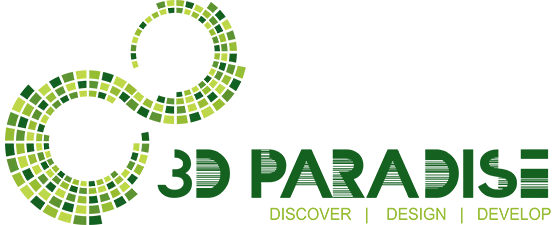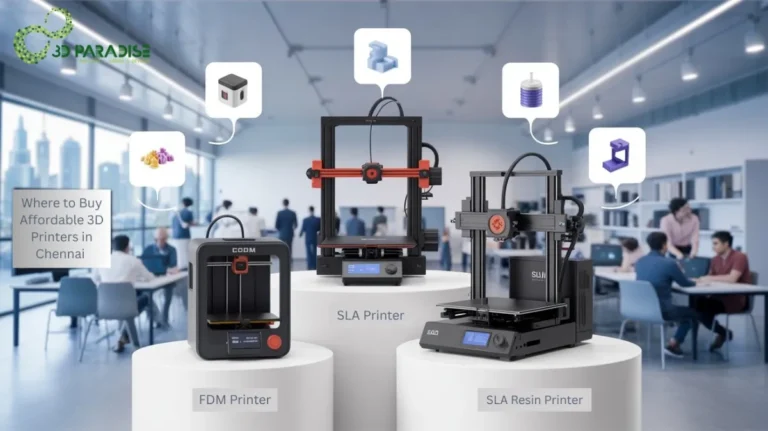Which Of The 4 Types Of 3D Printers Is The Most Common And Cost Effective?
Additive manufacturing, sometimes referred to as 3D printing, has transformed how we create, develop, and distribute goods across a great spectrum of sectors ranging from healthcare to aviation. Choosing the correct kind of 3D printer will either make or destroy your project whether you are a business owner prototyping a fresh concept or a hobbyist delving into your creative side.
This handbook concentrates on four main categories of 3D printing technologies:
PolyJet Printing, Fused Deposition Modeling (FDM), Stereolithography (SLA) and selective laser sintering (SLS).
Particularly with trusted models like our Ether and Plixo 3D printers made for experts and novices alike, FDM stands out as the most widely used and affordable solution among these.
Let’s explore the uses, advantages and disadvantages of each technology—and ultimately ascertain which one provides the best value for both businesses and regular consumers.
1. Fused Deposition Modeling (FDM): The Budget-Friendly Champion
What It Is?
Among the most often used 3D printing techniques is fused deposition modeling (FDM). It operates by pushing a spool of thermoplastic filament through a heated nozzle. The material melts and is layered on a building platform layer by layer, progressively growing the object from the ground up. While the build platform or nozzle alters vertically (Z-axis) to produce the layers, the print head travels in the X and Y axes. Cooling fans enable strong, practical prototypes and components by fixing every layer before the next is applied. FDM is most renowned for its cost-effectiveness, scalability, and simple approach.
What Causes It Popularity?
Because of its user-friendly operation, low starting cost, and capacity to print strong models with several materials, FDM is the ideal technology for novice and small enterprises. For those just starting to explore 3D printing, it offers a perfect starting point.
Advantages and Disadvantages
Pros Cons
| Low Cost: Entry-level devices cost about ₹80,000. | Less Detailed Resolution than SLA or PolyJet. |
| Material diversity: Compatible with PLA, ABS, PETG, TPU and many more | Slower Print Speeds for fine details. |
| User friendly: Easy to use with little upkeep | Layer lines apparent on finished prints. |
| Numerous open systems allow great customization. Open source options | Often need for smoother finish. |
Typical Uses
Mechanical prototypes and jigs
· Before finalizing a component, you need to test it; FDM makes it simple and inexpensive.
Education and STEM Projects
· Excellent for pupils; schools and universities employ it to create models for science, engineering, and robotics.
Toys and Daily Use Goods
· FDM enables you to produce practical and entertaining goods from phone stands to desk organizers at home or for your company.
Appliances and Automotive Spare Components
· Lost a little piece? You can quickly 3D print customized replacements for cars or equipment.
2. Stereolithography (SLA): Elegance Meets Accuracy
What It Is
Using a precise UV laser to harden liquid photopolymer resin layer by layer, stereolithography (SLA) is a resin-based three-dimensional printing technique. The resin solidifies immediately as the laser pulls each layer, producing very smooth and elaborately detailed objects. SLA is noted for its capacity to produce crisp edges, minute details, and near-injection-mold-like surfaces. It is perfect when appearance and precision are most important as it prints with liquid resin instead of filament; hence, it is widely used by companies needing visual perfection.
What Makes Professionals Love it?
Professionals utilize SLA when impeccable detail, surface smoothness, and great accuracy are absolutely non-negotiable. In sectors like dentistry, jewelry, and product design where even minor flaws are intolerable, it is the preferred technology.
Benefits and drawbacks
| Pros | Cons |
| Prints extremely minute detail on smooth surfaces | Higher Cost: Printers and resins are more costly than FDM |
| Ideal for small, complex pieces such jewelry and dental models | Post-processing needed: Require washing and UV curing. |
| Material variety: Rigid, flexible, castable, and even biocompatible resins on the market provide | Safety Precautions: Resin handling needs gloves, masks, and proper ventilation. |
Typical Uses – With Simple Explanations
Dental Models and Aligners
· For printing extremely precise dental tools like crowns, aligners and surgical guides with medical-grade accuracy.
Jewelry design
· For its capacity to print thin, delicate designs ideal for casting, sla is loved by jewelers.
Miniatures and Figurines:
· Great for creators and collectors—SLA vividly illuminates every little detail of a character or model.
Mobile Design Models
· SLA meets product designers’ needs for smooth, presentation-ready models resembling actual products.
Art and Sculpture:
· Artists use it to create physical masterpieces with perfect finishes from challenging digital sculptures.
Models of Medical Research
· Used to print anatomical features or surgical technique equipment because of its biocompatible resin choices.
3. Selective Laser Sintering (SLS): the industrial workhorse
What is it?
Professional-grade 3D printing technique (selective laser sintering) SLS fuses nylon powder particles together, layer by layer, using a strong laser to produce solid objects. Inside a heated chamber, where the laser is used to draw each cross-section of the model, sintering the powder into a solid. Once one layer is completed, more powder is applied and the laser keeps going. No support structures are required—the unutilized powder by itself holds the component during printing—one big benefit.
With complete freedom, this lets you print very intricate, interlocking, or hollow designs—something traditional methods fall far short of. Making genuine, functioning parts is difficult, exact, and excellent.
The reasons it stands out
Engineers and designers adore SLS because it lets quick prototyping of robust, functional parts—even in complicated shapes that other technologies have trouble with. Moreover, it is ideal for producing several components in one print run (batch manufacturing).
Advantage and Disadvantage
Pros Cons
| Pros | Cons |
| Ideal for practical mechanical applications are strong, durable components. | High Cost: Machines are expensive—often ₹20–50 lakhs or more. |
| Great for post-processing and exacting powder handling | Messy Process: Requires careful powder handling and post-processing. |
| Ideal for Batch Production: Prints several objects simultaneously effectively. | Needs Industrial Setup: Not suitable for home or hobby users. |
Typical Uses
Functional Testing
· SLS is used by companies to create robust prototypes when they want to examine the behavior of a product in the real world—like under pressure or heat.
Medical Orthotics and Instruments
· SLS is sometimes used to print custom braces, prosthetics, and other medical equipment for strength and comfort fit.
Working Electrical Components
· Engineers produce ready-to-use gears, casings, hinges, and clips directly from the machine.
Small Batch Manufacturing
· Need 50–100 parts right away? SLS is ideal for printing several units without making molds.
4. PolyJet: The 3D Printing Deluxe Sedan
How It Is
For 3D, PolyJet is an inkjet printer. It sends small drops of liquid photopolymer onto a build platform and immediately cures them with ultraviolet light instead of using ink. It produces smooth and detailed parts at ultra-fine resolutions layer by layer. The capacity of PolyJet to combine colors and materials within a single print makes it stand out—so you may replicate a variety of textures, rigidity levels, or even print lifelike skin tones and flexible joints at once.
Consider it as the luxury sedan of 3D printing: elegant, exact, and visually striking.
Why it’s premium
Designers and engineers use PolyJet when they need presentable components with a feeling and appearance like the final product. Particularly in fields like medical modeling, product demos, and conceptual design, when aesthetics, realism, and accuracy are essential, it is perfect.
Advantages and Disadvantages
| Pros | Cons |
| Gorgeous Surface Finish: prints that is nearly polish-free and smooth. | very costly: High initial and ongoing costs. |
| One print simulates textures, soft-touch components, and bright graphics in full-color and multi-material | High maintenance: necessitates regular calibration and cleaning. |
| High maintenance: necessitates regular calibration and cleaning. | Material Cost: Photopolymers employed are more costly than conventional filaments or resins. |
Common Use Cases
Realistic Medical Models
- Excellent for training or planning surgery, surgeons and medical students use this to examine human anatomy with real-color organs, veins, even tissue textures.
Prototypes for Luxury Consumer goods
- PolyJet can print completely built items with branding, buttons, and color so that you may present investors a prototype resembling something coming off the production line.
Mockups of cosmetics and packaging
- Brands use it to check packaging designs, such lotion bottles, cosmetics cases, or perfume bottles, with actual labels, colors, and texture.
Creative Design Validation
- Before production starts, designers use PolyJet to see and evaluate challenging design concepts—what looks good, what seems right.
Ideas in Fashion and Footwear
One piece of printed shoes, wearable or fabric-like textures can be used to investigate comfort and aesthetic appeal.
Which Kind Is Most Affordable and prevalent?
FDM dominates and for good reason.
Why?
Because it strikes the ideal mix of price, convenience, and dependability, FDM (Fused Deposition Modeling) is the most widely used 3D printing technology today.
This is the reason it heads the pack:
• Low startup cost: FDM printers are the cheapest to purchase and service. At a small portion of the price of SLA, SLS, or PolyJet printers, you may obtain a passable quality printer.
• Cheap Components: PLA and ABS filaments are readily accessible and reasonably inexpensive—ideal for daily printing.
• Easy to Use and Maintain: Little training will allow even novices to get started printing. Furthermore simple and without need of particular circumstances is maintenance.
• Most FDM printers enable consumer’s total control and flexibility by their open-source hardware and software support.
• FDM is “good enough” for most practical needs—especially for prototyping and functional components—although not as detailed as SLA or PolyJet.
Who most often uses it?
The preferred solution for:
• First-time consumers: Will find it ideal for studying because of its simple configuration and affordable choices.
• Schools and colleges: Employ it to impart design, engineering and problem-solving skills.
• Startups and small businesses: Excellent for prototyping and limited-volume manufacturing without breaking the bank are startups and small businesses.
• Maker Spaces and Community Labs: Flexible, dependable, and able to print a great diversity of items.
In summary:
Although SLA and PolyJet provide great detail and SLS provides strength and complexity, they call for significant investments and expert handling.
FDM equips you to create, test and build without overthinking expense or complexity whether you are a student, entrepreneur or hobbyist.
FAQ
1: Which 3D printer at home is simplest to use?
A: FDM printers are regarded as the most user-friendly because of their easy design and minimal upkeep.
Q2: What FDM printer price is?
A: Reliable FDM printers start for about 40,000; mid-range models with greater accuracy and longevity cost between 80,000 and 1, 00,000.
Q3: An FDM printer allows me to print high-detail models.
A: SLA printers are more appropriate for very fine and smooth finishes, although you may obtain good detail.
Q4: For company prototyping, which three-dimensional printing process would best fit?
A: For simple prototypes, FDM is suitable; however, based on your product needs, SLA or SLS might be preferable for intricate or robust components.
Q5: Mass production via PolyJet technology is appropriate?
A: No, it fits models and high-detail prototypes. SLS or FDM is most suited for production.
Q6: Which 3D printing method is most suitable for classrooms? A: Because of its low post-processing requirements and safe materials, FDM is especially popular in educational settings.



